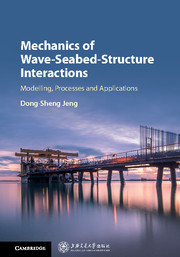Book contents
- Frontmatter
- Contents
- Preface
- 1 Overview
- 2 Basic Seabed Mechanisms
- 3 Soil Response in Marine Sediments under Combined Loading of Waves and Currents
- 4 Integrated Model of Wave-Seabed Interactions around Caisson-Type Breakwaters
- 5 Mechanics of Wave-Seabed-Pipeline Interactions
- 6 Three-Dimensional Model of Wave-Seabed Interactions around Breakwater Heads
- 7 Seabed Instability around Offshore Wind Turbine Foundations
- 8 Physical Modelling: One-Dimensional Compressive Tests
- Appendix A Analytical Solution for a Seabed of Finite Thickness (Hsu & Jeng 994)
- Appendix B Derivation of u–p Approximation (Jeng et al. 1999)
- Appendix C Derivation of u–U Approximation (Cha et al. 2002)
- Appendix D Mathematical Derivations of Analytical Solutions for Residual Soil Response (Jeng et al. 2007)
- Appendix E Mathematical Model of the Two-Layered Viscous Fluid System (Liu et al. 2009)
- References
- Author Index
- Subject Index
8 - Physical Modelling: One-Dimensional Compressive Tests
Published online by Cambridge University Press: 28 April 2018
- Frontmatter
- Contents
- Preface
- 1 Overview
- 2 Basic Seabed Mechanisms
- 3 Soil Response in Marine Sediments under Combined Loading of Waves and Currents
- 4 Integrated Model of Wave-Seabed Interactions around Caisson-Type Breakwaters
- 5 Mechanics of Wave-Seabed-Pipeline Interactions
- 6 Three-Dimensional Model of Wave-Seabed Interactions around Breakwater Heads
- 7 Seabed Instability around Offshore Wind Turbine Foundations
- 8 Physical Modelling: One-Dimensional Compressive Tests
- Appendix A Analytical Solution for a Seabed of Finite Thickness (Hsu & Jeng 994)
- Appendix B Derivation of u–p Approximation (Jeng et al. 1999)
- Appendix C Derivation of u–U Approximation (Cha et al. 2002)
- Appendix D Mathematical Derivations of Analytical Solutions for Residual Soil Response (Jeng et al. 2007)
- Appendix E Mathematical Model of the Two-Layered Viscous Fluid System (Liu et al. 2009)
- References
- Author Index
- Subject Index
Summary
Introduction
Theoretical studies of wave-seabed interactions have been reviewed in the literature (Jeng 2003c). Among these, based on Biot's consolidation theory (Biot 1941), Yamamoto et al. (1978) proposed an analytical solution for the wave-induced soil response in an infinite seabed. This framework was further extended to threedimensional short-crested wave-induced seabed response in a seabed of finite thickness (Hsu & Jeng 1994) and a layered seabed (Hsu et al. 1995). Later, many theoretical studies of more complicated wave and seabed conditions were reported, for example, cross-anisotropic soil behaviour (Jeng 1997b; Kitano & Mase 1999), non-homogenous seabeds (Jeng & Seymour 1997a; Kitano & Mase 2001), inertial effects (Jeng et al. 1999; Jeng & Rahman 2000; Ulker et al. 2009), full dynamic soil behaviour (Jeng & Cha 2003; Ulker et al. 2009) and combined wave and current loadings (Ye & Jeng 2012a; Wen et al. 2012; Zhang, Jeng, Gao & Zhang 2013).
In addition to the theoretical studies, several laboratory studies have been reported in the literature. Experimental studies mainly include two-dimensional wave-flume tests (Tsui & Helfrich 1983; Sumer et al. 1999) and one-dimensional compressive tests (Zen & Yamazaki 1990a, 1990b; Chowdhury, Dasari & Nogami 2006) and centrifuge tests (Sassa & Sekiguchi 1999; Sassa et al. 2001). The purpose of two-dimensional flume experiments was mainly to capture the pore pressure build-up, while the purpose of one-dimensional tests was generally to capture the response of soil to oscillatory pore pressure. In addition, the drawback of two-dimensional experiments (including waveflume tests and centrifuge tests) was the limited number of measurable points in a shallow soil layer (about three or four measurement points in a cross section of 10 cm). On the other hand, the advantages of one-dimensional laboratory experiments was the thick soil layer, which allows us to have more measurable points in the vertical profile of pore pressures, especially in the region near the seabed surface. Thus, a one-dimensional facility was used in this chapter to resolve the vertical profile of pore pressure distributions. All the aforementioned one-dimensional compressive tests (Zen & Yamazaki 1990a, 1990b; Chowdhury et al. 2006) were performed with 500 cycles. This limitation was overcome by the author in his recent work (Liu et al. 2015).
A few experimental studies about clayey soils have been performed in the past few decades.
- Type
- Chapter
- Information
- Mechanics of Wave-Seabed-Structure InteractionsModelling, Processes and Applications, pp. 285 - 315Publisher: Cambridge University PressPrint publication year: 2018

